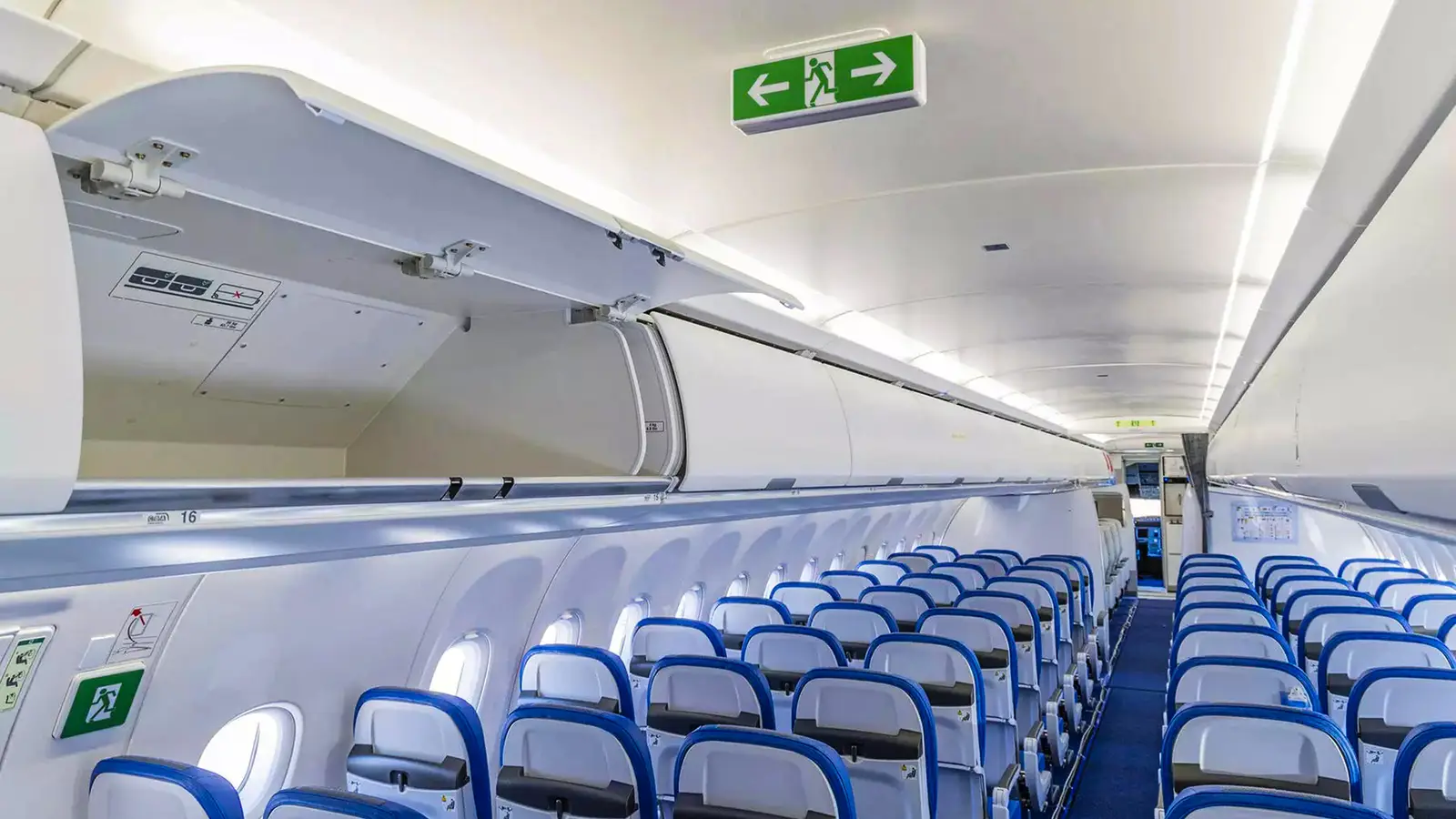Copyright Simple Flying

The Airspace cabin is one of Airbus’ signature design features, found across many of its newer aircraft, including the popular A321neo. Designed with flexibility in mind, it allows airlines to configure the cabin more efficiently, fitting additional seats and, in turn, boosting potential revenue, without compromising passenger comfort. In this article, we will take a closer look at the Airspace cabin concept and explore how it manages to create a greater sense of space for passengers onboard. We will also highlight two of Airbus’ latest aircraft to feature the design - the long-range A321XLR and the versatile A220 - both of which showcase the manufacturer's ongoing focus on comfort, efficiency, and modern design. Introducing The Airspace Cabin Airbus’ Airspace cabin represents the European manufacturer’s latest approach to passenger comfort, design efficiency, and brand consistency across its modern aircraft family. First introduced on the Airbus A350 back in 2017, the Airspace concept has since been adapted to other aircraft, including the A320neo family and the A220, giving passengers a more open, comfortable, and connected experience in the sky. At its core, the Airspace cabin is about maximizing comfort without sacrificing efficiency. Every element, from the redesigned sidewalls and ambient lighting to the wider aisles and larger windows, is intended to create a sense of spaciousness, even on narrowbody aircraft such as the Airbus A321neo. The larger Airspace XL overhead lockers can also store up to 60% more cabin baggage, reducing passenger frustrations while speeding up boarding and disembarkation for airlines. When it comes to passenger comforts, Airbus has incorporated softer cabin lighting into its Airspace cabin design, with over 16 million customizable color tones to match the time of day, helping to reduce jet lag on longer routes. Enhanced sound insulation ensures a noticeably quieter environment, while improved air filtration and humidity control contribute to fresher cabin air throughout the flight. Connectivity also plays a key role in the Airspace experience, and the cabin supports high-speed Wi-Fi, USB-C power at every seat, and integrated mood lighting that complements the airline’s branding. Public aircraft delivery records show that Delta Air Lines was likely the world's first carrier to take delivery of an aircraft equipped with the Airspace cabin - this was an Airbus A350-900 in July 2017. The first aircraft of each type to be delivered with the Airspace cabin are outlined in the table below: More Seats = More Revenue While the Airspace cabin was designed with passenger comfort in mind, it also brings clear financial advantages for airlines. One of the biggest benefits lies in the cabin’s flexible layout, which allows operators to tailor seating configurations to their business model. The optimized use of space enables airlines to fit additional rows or more premium seating without compromising comfort, effectively increasing overall capacity and, therefore, potential revenue per flight. In today's increasingly competitive commercial aviation market, seemingly small increases in revenue, such as this, can make a significant difference to overall financial performance. When it comes to operational efficiency, the Airspace XL overhead lockers, which can hold up to 60% more cabin bags, also contribute to faster boarding and disembarkation times. This improved turnaround efficiency means aircraft spend less time on the ground and more time in the air, directly translating to higher utilization and reduced operational costs. Airbus has also ensured that its Airspace cabins support a consistent passenger experience across its aircraft family. This design continuity helps airlines strengthen brand identity and passenger loyalty, which can lead to higher yields over time, with the theory being that passengers who associate the Airspace cabin with comfort and modernity are more likely to choose airlines operating similar Airbus aircraft in the future. Additionally, the improved lighting, air quality, and connectivity options can enhance customer satisfaction scores, which are important metrics for attracting and retaining passengers, especially in premium cabins. By combining operational efficiency with a better onboard experience, Airbus' Airspace cabin offers airlines a strong competitive edge, helping them generate greater revenue while maintaining passenger comfort and loyalty across every route. The Airbus A321XLR One of the aircraft on which the Airspace cabin really comes into its own is the Airbus A321XLR. Despite being a narrowbody aircraft, clever use of the Airspace cabin helps to create a much more spacious, widebody feel onboard the extra-long-range aircraft. Passengers are sure to appreciate these additional comforts when airlines deploy the aircraft on long-haul routes. The Airbus A321XLR is a standout addition to the A320neo family, offering airlines a narrowbody aircraft capable of flying routes traditionally served by widebodies, reshaping the future of long-haul flying. Launched in 2019, the A321XLR builds on the A321LR’s long-range capabilities but extends the maximum range to around 5,400 miles (8,700 km). This allows carriers to connect medium-sized cities on transcontinental and even longer routes, such as those across the Atlantic, that were previously uneconomical with narrowbody aircraft. One of the defining features of the Airbus A321XLR is its combination of efficiency and flexibility. With its new, lighter-weight landing gear, modified fuel tanks, and an optimized wing trailing-edge flap, Airbus has reduced the aircraft’s operating costs per seat while maximizing range. This makes the A321XLR particularly appealing for low-cost carriers and full-service airlines alike, enabling profitable long-haul operations on longer, thinner routes. Passenger experience was also a major focus when it came to the design of the Airbus A321XLR. This latest aircraft comes equipped with the Airspace cabin, offering wider overhead bins, LED mood lighting, and a spacious, quiet interior. The Airbus A321XLR entered commercial service in 2024, and the aircraft has already attracted strong interest globally, with carriers like American Airlines, JetBlue, and IndiGo among those that have placed significant orders. Opening Up New Routes The latest data from ch-aviation shows that Iberia is currently the world's largest operator of the A321XLR, deploying the aircraft on routes to several transatlantic destinations from its hub at Madrid Barajas Airport (MAD), including to Boston Logan International Airport (BOS), Washington Dulles International Airport (IAD), and San Juan Luis Muñoz Marín International Airport (SJU). The oneworld carrier will also shortly begin A321XLR services to Fortaleza–Pinto Martins International Airport (FOR) and Recife/Guararapes–Gilberto Freyre International Airport (REC), marking the A321XLR's first routes to South America. Another recently announced high-profile route flown by the Airbus A321XLR is Air Canada's new summer-seasonal service between Montréal–Trudeau International Airport (YUL) and Palma de Mallorca Airport (PMI), which is due to commence in 2026. The Next Aircraft To Feature The Airspace Cabin The Airbus A220 is set to be the next aircraft in Airbus' growing catalog to be fitted with the Airspace cabin, the first of which is expected to roll off the production line in early 2026. The A220, originally developed by Bombardier as the CSeries, represents a new generation of single-aisle aircraft optimized for efficiency, comfort, and performance on short- and medium-haul routes. Now fully integrated into Airbus’ catalog of aircraft, the A220 comes in two variants: the A220-100, seating around 100–120 passengers, and the A220-300, which carries approximately 120–150 passengers. One of the key selling points of the Airbus A220 is its exceptional fuel efficiency. Thanks to advanced aerodynamics, lightweight materials, and the Pratt & Whitney PW1500G geared turbofan engines, the A220 delivers up to 20% lower fuel burn per seat compared to older aircraft in its class. This makes it especially attractive for airlines looking to reduce operating costs and environmental impact. Passenger comfort is another highlight. The A220 features a wider cabin than most aircraft in its class, large windows, and a quieter interior, giving travelers a more spacious and pleasant experience. Modern features like the Airspace cabin, adjustable LED lighting, and advanced in-flight connectivity further enhance comfort, allowing airlines to offer a consistent experience across their Airbus fleet. With its combination of efficiency, range, and comfort, the A220 is quickly becoming a favorite among regional and low-density long-haul routes. In the US, airlines such as Delta Air Lines, Breeze Airways, and JetBlue have embraced the aircraft, using it to open new markets, improve operational flexibility, and deliver a modern flying experience for passengers worldwide. The Largest Operators Of The Airbus A220 Delta Air Lines is by far the world's largest operator of the Airbus A220, with a total of 80 in its fleet (45 A220-100s and 35 A220-300s), which will gradually replace the carrier's aging Boeing 717s. The SkyTeam carrier is followed by JetBlue and airBaltic, with 54 and 50 A220s, respectively. Delta Air Lines was the first North American carrier to operate the smaller A220-100 variant, while Air Canada was the first to take delivery of the larger A220-300. The table below shows the world's largest operators of the Airbus A220, as of November 2025:



